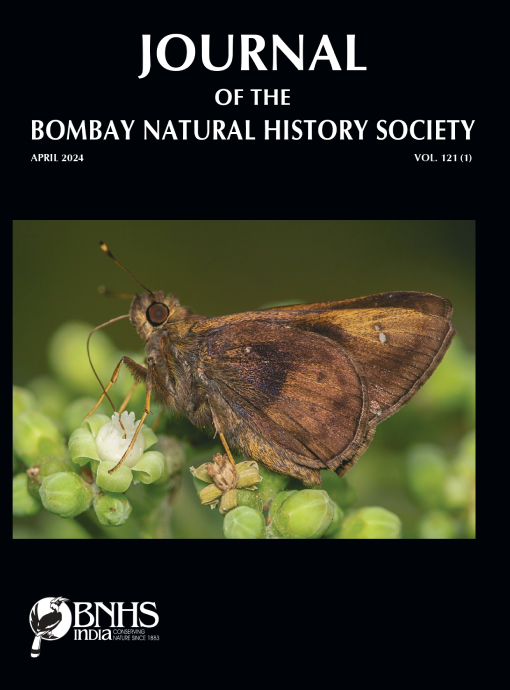Abstract
No Abstract.References
Champion, H.G. & S.K. Seth (1968): A revised survey of the forest types of India. Manager of publications.
Chakraborty, P., T. Sharma, J. Borah & A. Sarmah (2015): Faunal diversity in a semi-evergreen forest of Bornadi-Khalingduar Complex of Assam, India. Journal of Threatened Taxa 7(11): 7770–7775.
Chen, W., C. Newman, Z. Liu, Y. Kaneko, K. Omote, R. Masuda, C.D. Buesching, D.W. Macdonald, Z. Xie & Y. Zhou (2015): The illegal exploitation of hog badgers (Arctonyx collaris) in China: genetic evidence exposes regional population impacts. Conservation genetics resources 7(3): 697–704.
Choudhury, A. (2013): The Mammals of Northeast India. Gibbon Books, Guwahati, p. 205.
Choudhury, M.R., P. Deb, H. Singha, B. Chakdar & M. Medhi (2016): Predicting the probable distribution and threat of invasive Mimosa diplotricha Suavalle and Mikania micrantha Kunth in a protected tropical grassland. Ecological Engineering 97: 23–31.
Datta, A., R. Naniwadekar & M.O. Anand (2008): Hornbills, hoolocks and hog badgers: long-term monitoring of threatened wildlife with local communities in Arunachal Pradesh, north-east India. Final report to the Rufford Small Grants Program (UK). Nature Conservation Foundation, Mysore, India, p. 80.
Ghose, P.S., P. Shrestha, L.T. Theengh, T. Pintso & B.K. Sharma (2014): Records of small carnivores in Barsey Rhododendron Sanctuary, Sikkim, India. Small Carnivore Conservation 51: 42–45.
Helgen, K.M., N.T. Lim & L.E. Helgen (2008): The hog-badger is not an edentate: systematics and evolution of the genus Arctonyx (Mammalia: Mustelidae). Zoological Journal of the Linnean Society 154(2): 353–385.
Indian Express (2020): Vulnerable Hog Badger spotted ‘for first time’ in Tripura: 3 cubs rescued. Available at: https://indianexpress.com/article/north-east-india/tripura/vulnerable-hog-badger-spotted-for-first-time-in-tripura-3-cubs-rescued-6458826/
Jhala, Y.V., Q. Qureshi & S.P. Yadav (2020): Status of leopards in India, 2018. National Tiger Conservation Authority, Government of India, New Delhi, and Wildlife Institute of India. Dehradun. Technical Report TR/2020/16.
Kundu, S., V. Kumar, K. Tyagi, S. Rath, A. Pakrashi, P.C. Saren, L. Kosygin & K. Chandra (2019): Mitochondrial DNA detects Arctonyx collaris from burnt body parts: a wildlife forensic case study in Indo-Burma biodiversity hotspot. Mitochondrial DNA Part B, 4(1): 1172–1176.
Lalthanzara, H. (2017): A systematic list of mammals of Mizoram, India. Science Vision 17(2): 104–121.
Mathur, V.B., A. Verma, N. Dudley, S. Stolton, M. Hockings & R. James (2005): Opportunities and challenges for Kaziranga National Park, Assam over the next fifty years. In: Enhancing Heritage, UNESCO-IUCN.
Mazumdar, K., R. Soud & A. Gupta (2011): Mammalian diversity of degraded forest habitats around Assam University campus, Cachar, Assam, India, with notes on conservation status. Our Nature 9(1): 119–127.
Myers, N., R. Mittermeier, G.C. Mittermeier, G.A.B. daFonseca & J. Kent (2000): Biodiversity hotspots for conservation priorities. Nature 403: 853–858.
Ramakrishna, S.Z. Siddiqui, P. Sethy & S. Dash (2006): Faunal Resources of Similipal Biosphere Reserve, Mayurbhanj, Orissa, Conservation Area Series, 28: 1–87 + 8 plates. Published by the Director, Zool. Surv. India, Kolkata.
Talukdar, N.R. & P. Choudhury (2017): Conserving wildlife wealth of Patharia Hills reserve forest, Assam, India: A critical analysis. Global Ecology and Conservation 10: 126–138.
Zhang, L., Y.B. Zhou, C. Newman, Y. Kaneko, D.W. Macdonald, P.P. Jiang & P. Ding (2009): Niche overlap and site resource partitioning for two sympatric species of badger. Ethology Ecology & Evolution 21(2): 89–100.

